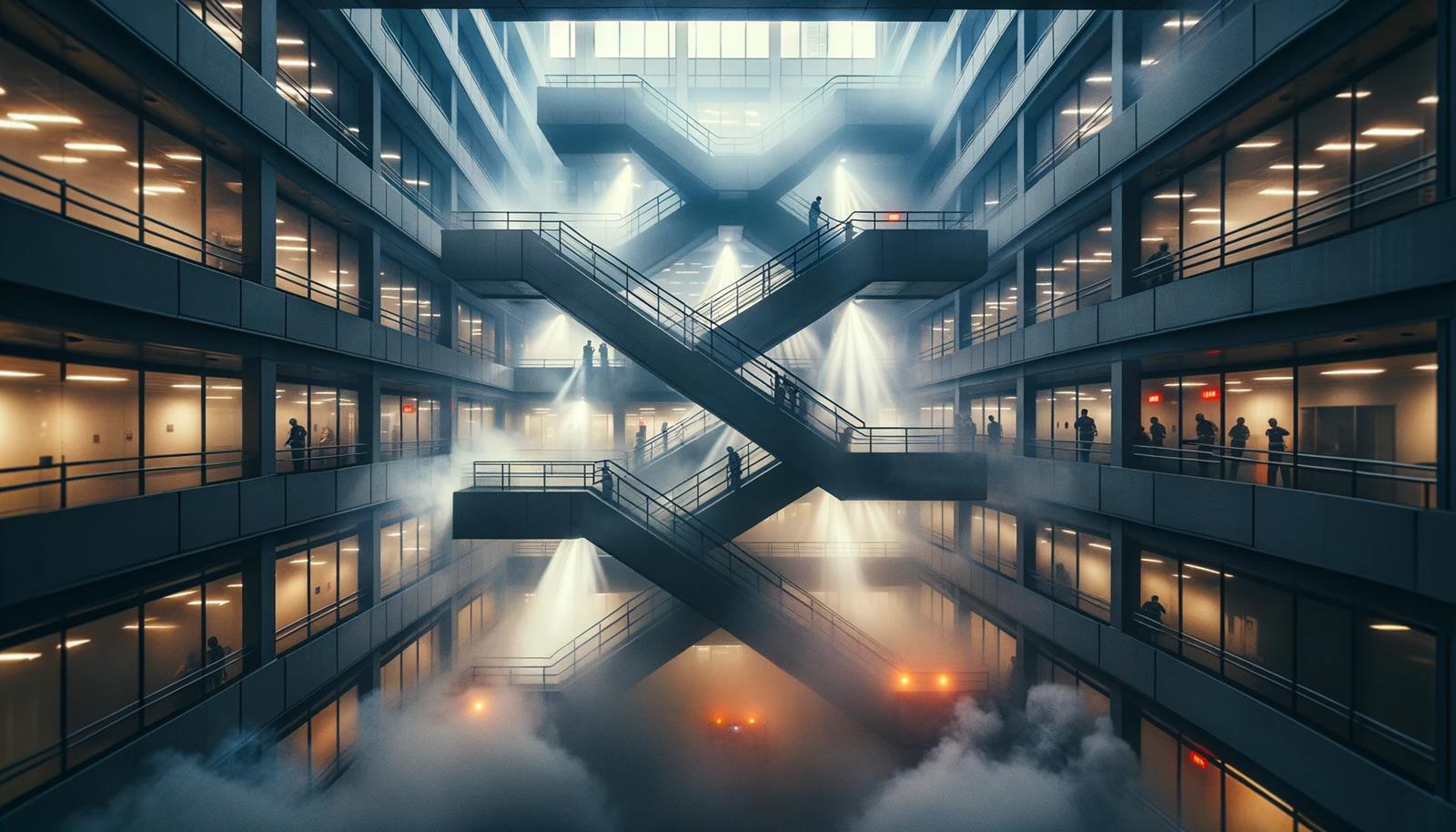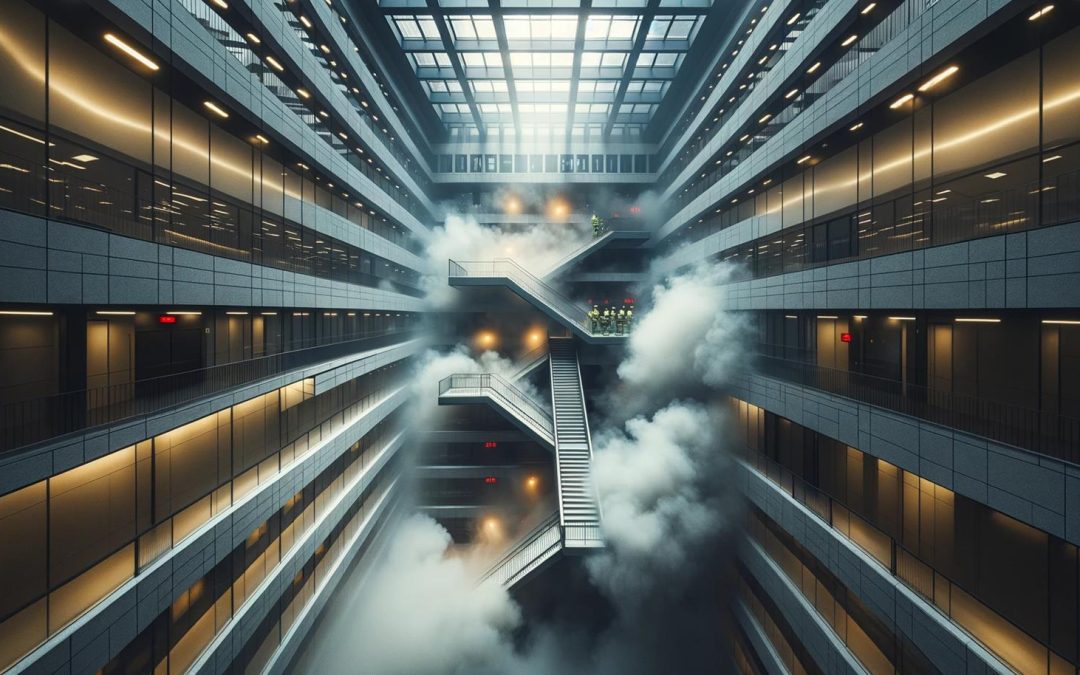Staircase overpressure systems are effective smoke control systems, often referred to as pressure differential systems, and are the most effective technique for protecting escape routes in multi-storey buildings. However, in order to be effective, they must consist of components with appropriate certificates, ensuring the highest reliability. How does an air transfer system work?
Are you interested in purchasing and installing a staircase overpressure system? Call our sales representative: Tel/fax.: +48 513 528 235
Table of contents:
Staircase overpressure systems – 4 main requirements
A pressure differential system in stairwells must be designed to meet four key requirements:
- Maintain overpressure: The system should provide stable overpressure in protected areas (such as stairs, lobbies, and elevator shafts), particularly when these areas are not connected to the rest of the building by open doors.
- Airflow Control: Maintain an adequate airflow velocity to prevent smoke from entering areas with open doors, both during evacuation and rescue operations.
- Door opening force: The system should regulate the differential pressure on both sides of the door, separating the protected areas from the non-protected areas, so that the force required to open them does not exceed the safe level of 100 N.
- System Responsiveness: Due to the frequent changes in the position of the door during the evacuation, the system must quickly switch between overpressure and flow modes. To effectively protect vertical escape routes, this time should be limited to a few seconds.
Operation of the staircase overpressure system
In order to meet the previously mentioned criteria, it is crucial to properly manage the differential pressure at the boundary between protected and non-protected overpressure zones. In most high-rise buildings and high-rise buildings, in accordance with local building codes and recognized engineering practices, the escape concrete staircase is separated from the rest of the floor by special areas that are designed to contain smoke. The doors between these areas and the horizontal escape routes are the aforementioned intersection points. Therefore, it is necessary to implement an air distribution system in these areas that will be able to precisely regulate the differential pressure and air flow.
Installation of a differential pressure system for air and smoke collection
An air and smoke extraction system should be installed on each floor of the building along areas not protected by overpressure, such as stairwells or open spaces. This system can include automatic smoke dampers that open, smoke ducts protected by fire dampers that are an integral part of the smoke extraction system, or mechanical extraction points located in strategic locations. Although the first two of these solutions do not require continuous airflow from pressurized areas to corridors, their effectiveness in removing smoke from individual floors can be significantly reduced.
Functioning of Air Transfer in Pressure Differential Systems
A key aspect in pressure differential systems is the air transfer area, which often proves to be too small to be effective. The designation of this area assumes that the air flow velocity through the opening is about 5 m/s, which is necessary to maintain adequate overpressure in the staircase. The size of the transfer openings depends on the purpose of the system – whether it is to be used only for evacuation or to support the operations of rescue teams. For efficiency, these openings should have a free cross-section of at least 0.27 m². For example, for standard door dimensions of 0.9 × 2.0 m² and assuming that a minimum airflow rate through a door opening of 0.75 m² is required, these requirements must be met.
Mechanical air transfer in pressure-power differential systems
The solution to the problems encountered is the use of simple and effective methods of mechanical air transfer. In pressure differential systems, when a fire is detected on a given floor, outside air is directed to the lobby and corridors on that level. The total amount of air supplied is determined based on the flow criteria. When the door separating the lobby from the rest of the building is closed, only a limited amount of air enters the stairwell, necessary to maintain the required overpressure in relation to the horizontal escape routes. This air enters the first floor through leaks in the building structure. The rest of the air is directed directly to the horizontal escape routes via a special transfer channel.

Advantages of electronically controlled air transfer in differential pressure systems
Electronically controlled air transfer, operating according to the principles described, offers numerous advantages compared to traditional, fixed openings.
- Ease of installation
Gulajski systems do not require additional space on the walls in lobbies, making them ideal even for lobbies with limited space. The system components can be easily installed in hidden spaces, such as cellular voids. In addition, by placing transfer grilles in the ceiling, the aesthetics of the usable space is increased. - Precise overpressure and flow control
Gulajski’s electronically controlled transfer is a solution that allows for precise adjustment of overpressure and air flow conditions, reacting to dynamic changes in the fire situation. Constant monitoring of the differential pressure allows you to correct the airflow distribution on an ongoing basis, ensuring that the overpressure is constantly maintained at a safe level. - Consistent Airflow
Thanks to its electronic control, the Gulajski system ensures a constant flow of air to horizontal escape routes, regardless of the position of the escape door. This facilitates the design and efficiency of air and smoke extraction systems. - Effective smoke extraction
A constant supply of air combined with the continuous operation of the exhaust system allows for effective smoke extraction from horizontal escape routes. This is possible when the rooms adjacent to the corridors are equipped with fire doors with automatic closers.
Gulajski systems represent a modern approach to fire safety, combining innovation with functionality, making them an excellent choice for modern buildings. Feel free to contact us: https://www.gulajski.pl/kontakt/
Autor: Tomasz Matuszek; Dział Marketingu - Firma Gulajski

